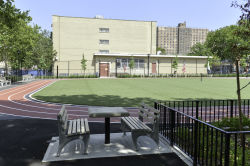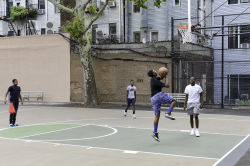Stockton Playground
Stockton Playground
Richard Stockton was born into a socially prominent Quaker family in Princeton, New Jersey on October 1, 1730. His great-grandfather had emigrated from England in 1670, and settled on Long Island before acquiring a 6,400-acre tract of land in New Jersey centered around what is now the town of Princeton. Richard Stockton had a distinguished early education, receiving honors from the College of New Jersey (now Princeton University) in 1748, before studying law under David Ogden, at that time the head of the legal profession in the province.
After his admission to the Bar, he practiced as both a counselor and an advocate before becoming Royal Council of New Jersey in 1765. A moderate with regard to demands for colonial autonomy, he argued that the colonies should be represented in the Parliament. He relinquished his professional business in 1766 in order to visit England, Scotland and Ireland. His travels proved remarkable. He was presented at the court of George III (1738-1820) and consulted on American affairs with the English aristocracy. Later, he fought off robbers in Edinburgh and narrowly escaped being killed in the Irish Sea when the boat he had planned to travel in was shipwrecked, drowning all on board.
Stockton returned to America and was appointed a Justice of the Supreme Court of New Jersey in 1774. On June 21, 1776, the provincial congress of New Jersey elected Stockton as a delegate to the Continental Congress in Philadelphia. Stockton’s loyalties were somewhat divided; but, he eventually chose to side his influence with John Adams against the English monarchy and agreed to sign the Declaration of Independence. In November of that same year, British troops took Stockton prisoner after royalist neighbors betrayed him. Captured from his bed in the middle of the night, he was jailed in New York and his estate was plundered. Although he was eventually released, Stockton never fully recovered physically or financially from the ordeal. After several years of slowly declining health, he died in his home on February 28, 1781 at the age of 53.
The City acquired this property, located between Park Avenue and Floyd Street, East of Marcy Avenue, on May 8, 1957. The same year, the City also put aside money for the construction of three schools in the Fort Greene, Brooklyn Hill, and South Williamsburg areas of North Brooklyn: P.S. 297, P.S. 46, and J.H.S. 148. Before the development of these schools, the area was characterized by considerable physical decline. Land use was awkwardly mixed, while heavy traffic and decrepit properties tarnished the neighborhood. Most of the housing was built before 1900 with multiple, walk-up dwellings predominating.
Open space was rare in this environment, and rapid increases in population during the 1950s put more pressure on the little green space that did exist. The City made it a priority to provide adequate recreational space to improve the quality of life in the neighborhood. Multi-use public playgrounds were thought to be the most useful and economical form of open space. This playground was constructed in 1957, adjoining P.S. 297, and an Executive Decree named it Stockton Playground in 1987. The park features include handball courts, basketball courts, play equipment with safety surfacing, a spray shower, and a water fountain. Mayor Giuliani funded a $314,139 renovation of the playground in 1998.
Check out your park's Vital Signs
Clean & Safe
Green & Resilient
Empowered & Engaged Users
Share your feedback or learn more about how this park is part of a
Vital Park System










